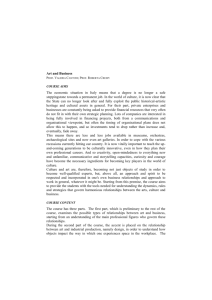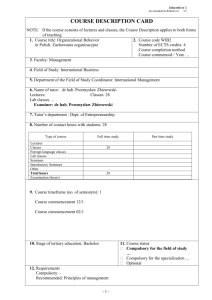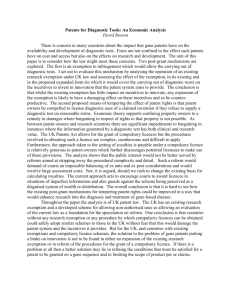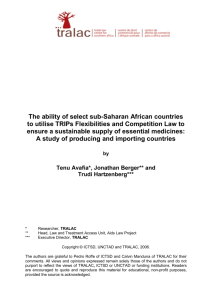Letter from Michelle Childs from CPTech to EC Commissioners
advertisement
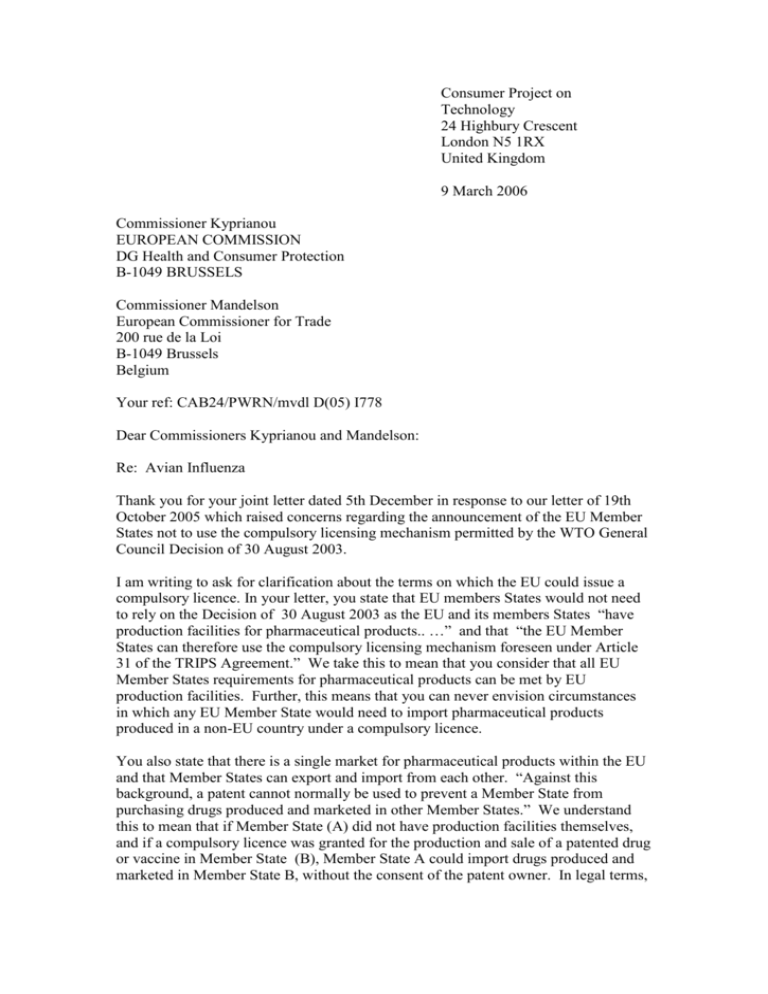
Consumer Project on Technology 24 Highbury Crescent London N5 1RX United Kingdom 9 March 2006 Commissioner Kyprianou EUROPEAN COMMISSION DG Health and Consumer Protection B-1049 BRUSSELS Commissioner Mandelson European Commissioner for Trade 200 rue de la Loi B-1049 Brussels Belgium Your ref: CAB24/PWRN/mvdl D(05) I778 Dear Commissioners Kyprianou and Mandelson: Re: Avian Influenza Thank you for your joint letter dated 5th December in response to our letter of 19th October 2005 which raised concerns regarding the announcement of the EU Member States not to use the compulsory licensing mechanism permitted by the WTO General Council Decision of 30 August 2003. I am writing to ask for clarification about the terms on which the EU could issue a compulsory licence. In your letter, you state that EU members States would not need to rely on the Decision of 30 August 2003 as the EU and its members States “have production facilities for pharmaceutical products.. …” and that “the EU Member States can therefore use the compulsory licensing mechanism foreseen under Article 31 of the TRIPS Agreement.” We take this to mean that you consider that all EU Member States requirements for pharmaceutical products can be met by EU production facilities. Further, this means that you can never envision circumstances in which any EU Member State would need to import pharmaceutical products produced in a non-EU country under a compulsory licence. You also state that there is a single market for pharmaceutical products within the EU and that Member States can export and import from each other. “Against this background, a patent cannot normally be used to prevent a Member State from purchasing drugs produced and marketed in other Member States.” We understand this to mean that if Member State (A) did not have production facilities themselves, and if a compulsory licence was granted for the production and sale of a patented drug or vaccine in Member State (B), Member State A could import drugs produced and marketed in Member State B, without the consent of the patent owner. In legal terms, drugs produced under a compulsory licence, benefit from intra – community exhaustion. If we are correct in our interpretation of your position, this gives rise to a number of issues: There is the possibility that firms using compulsory licences in one EU Member State would not produce enough drugs to meet the needs of a Member State, which has no manufacturing capacity. Under Article 31 (F) of the TRIPS Agreement, any drugs produced under a compulsory licence can only be used “predominantly for the supply” of the domestic market for which the compulsory licence was issued. I.e, the drugs have to be mainly used for the needs of Member State B, so only a limited amount could be exported to Member State A. One way to avoid this problem would involve Article 31(k) of TRIPS. Under Article 31(k), if a compulsory licence were issued to remedy a practice determined after judicial or administrative process to be anti-competitive, the TRIPS restrictions on exports would not apply. However this approach can only be used following a process that will be problematic for many important cases. In most if not all EU Member States, this will involve a competition investigation and a finding of abuse before a licence can be issued. A finding of anti-competitive behaviour generally takes a long time, many months if not years in many EU Member States. When faced with an imminent threat or the need to urgently build stockpiles, or to protect access to medicines in cases involving excessive prices, it may be impractical to wait. If faced with a “predominantly supply the domestic market” problem, would the Commission seek to rely on competition law, and if so how would it ensure that a compulsory licence could be issued quickly? In cases not involving competition law, for example, cases where compulsory licenses are issued for government use, or to protect public health, it appears under EU case law, as if patent owners will be able to block the free movement of goods when compulsory licenses are issued . The assertion that there is intra-community exhaustion and so the ability to freely export and import within the EU , therefore appears to be inconsistent with EU case law. As far as we are aware, the European Court of Justice (ECJ) has expressly held that a drug put onto the market by a compulsory licensee in one EU Member State did not exhaust the patents holder’s right to block importation of that drug into another EU member State (Pharmon v Hoechst (Case 19/84, 1985 ECR 2281) . This principle was reaffirmed in Merck & Co v Primecrown Ltd ( joined cases C-267/95 and C-268/95,1996 ECJ). We would be grateful if you would clarify your position in relation to this apparent inconsistency. Given the apparent difficulties presented by patent case law, in situations involving an avian flu pandemic or similar public health crisis, would the Commission seek to use competition law only to obtain compulsory licences that allow exports and imports within the European Union? If so, how would the Commission seek to avoid the delay problems highlighted above? To make these issues more concrete in the case of the avian flu issue, consider the following. First, very few EU Member States now have sufficient stockpiles of antiviral medicines, according to the WHO. Second, the limited voluntary licensing 2 by Roche of the patents needed for generic production of Tamiflu have not overcome the current supply constraints. Third, the prices for stockpile products are very high, given the recommended stockpile sizes and the limited incomes of some EU Member States. Fourth, there are now new patent applications on some new processes for manufacturing Tamiflu and other antiviral medicines. The Commission is aware that there are also problems of vaccine supply that must be addressed. This is acknowledged in the latest report on Avian Influenza available on the DG Sanco website, which states that under present conditions, “shortage of vaccine supply is probable” Such problems include the fact that there exists considerable concentration of the capacity for manufacturing vaccines -- less than a half dozen EU Member States are likely to be able to produce substantial amounts of an avian flu vaccine. It is therefore essential that there are quick and timely mechanisms to ensure access to vaccines across all EU member States. There exist a number of important patent barriers for the processes of manufacturing vaccines for avian flu, and there is no voluntary patent pool to ensure that these patent problems can be overcome should a pandemic occur. Our concerns are not academic; and go to the heart of the Commission’s ability to respond to public health problems in a timely and appropriate manner. We would be grateful therefore if you will respond to them as a matter of urgency. Yours Sincerely Michelle Childs Head of European Affairs Consumer Project on Technology 3

